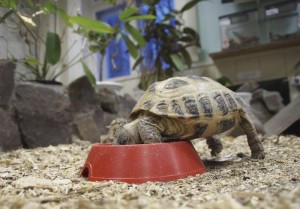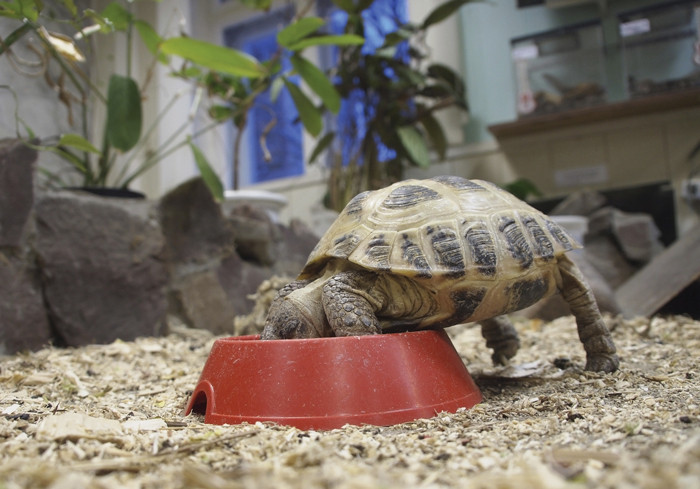Dish Wish List
Erik J. Martin //June 4, 2014//
 It wasn’t long ago that pet reptiles were primarily eating off of what amounted to cheap Dixie plates in the form of plain plastic pet dishes, available in very little variety.
It wasn’t long ago that pet reptiles were primarily eating off of what amounted to cheap Dixie plates in the form of plain plastic pet dishes, available in very little variety.
Today, however, manufacturers are offering the equivalent of fine china, as evidence by the bountiful array of better-designed bowls, feeders and receptacles — made to look more natural, keep the edibles contained within, and even increase the appetites of some herps.
New and Improved
While the trend of producing containers that look and feel like real rock and wood isn’t new, these products continue to be tweaked and enhanced. Most faux rock/wood bowls are now dishwasher safe and bacteria resistant, with smoother, nonporous surfaces, unbreakable, simpler to clean, more realistic looking and available in low- or high-profile designs for different-sized reptiles.
A wider assortment of sizes and shapes are also provided, including space-saving wedge-shaped options for cage corners, such as Fluker’s 4-inch-long corner bowl and Zoo Med’s Repti-Rock Corner dish.
“Lots of them are now made to blend in with the habitat, and some even glow in the dark,” Amber Andersen, DVM, veterinarian and owner of Redondo Veterinary Medical Center in Redondo Beach, Calif., said.
A good example of the latter is Conceptual Creations’ azure-colored Small Animal Glow Dish.
Fab Fine Designs
Keeping a food or water dish secured in a preferred place within the cage can be a challenge with some frisky reptiles, but several manufacturers offer clever solutions. One is Pet-Tech, whose MagNaturals line of feeder/water rock ledges use magnetic power to lock the ledge against the side of the terrarium glass.
“The MagNaturals have been my top seller for a while,” Richard Allen, owner of Reptile Rapture, a Madison, Wis.-based retailer, said. “What’s nice is that some of these ledges have bowls that can be removed from the ledge for quick and easy filling and cleaning. I have an 8-foot shelf dedicated solely to this product line, and my customers love them.”
Pet owners are also clamoring for better solutions to keep live foods from crawling out of dishes.
“There are now more bowls for mealworms with curved sides so the worms can’t escape, and new bowls for Dubia roaches that have slick sides so that the roaches are unable to crawl up and out,” said Andersen, who notes that many manufacturers have rolled out dishes in recent years with special lips, edge rings and deeper bowls for these purposes.
Fresh Ways to Feast
Reptiles like bearded dragons, geckos and skinks that munch on live mealworms now have another option, the new Mealworm Feeder by Zoo Med, which is hung via suction cup at any height on a terrarium’s glass wall.
“This product is transparent, allowing your reptiles to see the live worms inside,” Ashley Rademacher, animal care and education coordinator for Zoo Med Labs, Inc., in San Luis Obispo, Calif., said. “It provides enrichment as reptiles watch the worms slowly crawl out of the holes in the bottom of the cup. The feeder can be placed high on the wall to allow worms to gradually fall into a clean food dish, which needs to be placed under the feeder to prevent lizards from eating worms directly off the substrate. Or the feeder may be placed lower to allow animals to grab worms directly out of the cup as they emerge from the holes.”
For pets who feast on crickets, Exo Terra’s Reptile Cricket Feeder can be an ideal solution. Built to resemble a hollow rock with a hole in the side for crickets to climb out of, this feeder allows owners to pour vitamin powder within the rock and then add crickets who become coated with the powder. This prevents the buildup of vitamin residue on the substrate, which can harbor harmful bacteria, especially in humid terrarium conditions.
Clever Containers
There’s even a new vibrating feeder dish, the Vivicator by Exo Terra, that vibrates at high frequency via remote control to mimic the motion and movement of animated insects on the rubber feeding platform provided. Because insectivorous herps are triggered by movement, they will be instantly attracted to the items in motion, whether it’s pellets, canned insects or freeze-dried foods.
Combining a food dish with a crawl space is another innovative way to add value to a product in this category, as demonstrated by Fluker’s Castle Crib, which bundles a basking platform, reptile hideaway and food bowl into one item, ideal for geckos and other small species.
“The Castle Crib is also a great solution for snakes, who like a nice, private, damp area when they go to shed,” Allen said. “They like to hide under the bowl.”
Out In the Open
Allen said it’s important for retailers to take these food bowl products out of the packaging and display them within cages so they can be tested on reptiles for sale and better showcased to shoppers.
“People need to see how these products work and how they look outside the box,” Allen said. “Often, the packaging hides the product, and if you don’t take it out and use it within your setups and displays, they may not otherwise sell.”



















